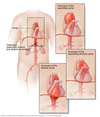Pathoma Vascular Pathology Flashcards
(18 cards)
Three categories of vasculitis and what defines each category and what are the examples in each category (2,3,4)
Large Vessel vasculitis: involves aorta and major branches. ex: Temporal (giant cell) arteritis and Takayasi arteritis
Medium-vessel vasculitis: involves muscular arteries that supply organs. Ex: Polyarteritis Nodosa, Kawasaki Disease, Buerger Disease
Small-vessel vasculitis: involves arterioles, capillaries, and venules. Ex: Wegner Granulomatosis (Granulomatosis with polyangitis), Microscopic Polyangitis, Churg-Strauss Syndrome, Henoch-Schonlein Purpura
Large Vesssel Vasculitis (2)
1. Temporal (giant cell) Arteritis: granulomatous vasculitis that classically involves branches of the carotis artery. Most common form vasculitis adults >50. F>M
Presentation: HA (temporal artery), Visual changes (opthalmic artery), jaw claudication. Can present with Polymyalgia rheumatica
Biopsy shows giant cells and intimal fibrosis. Lesions are segmental.
Tx: corticosteroids QUICKLY!
2. Takayasu Arteritis: very similar to Temporal, involves aortic artch at branch points. Neuro + visual sx. Adults <50 (young asian females) “pulseless disease”
Medium-Vessel Vasculitis (3)
1. Polyartertis Nodosa: multiple organs, lungs spared. Necrotising. Presents as HTN (renal artery), abd pain (mesenteric), neuro changes. Associated HBsAg. Early lesions transmural inflammation with fibrinoid necrosis. “String of pearls”
2. Kawasaki Disease: Asian children <4. Nonspecific sx. erythematous rash palms and soles. Coronary artery involvement. Can present as MI in child
Tx: ASA****, IVIG,
- Buerger Disease: Necrotising vasculitis involving digits. Ulceration, gangrene, autoamputation of fingers/toes. Associated with SMOKING**
Small Vessel Vasculitis (4)
1. Wegner Granulomatosis:“WeCner” necrotising granulomatous vasculitis involves nasopharynx, lungs, kidneys, c-ANCA, tx: cyclophosphamide, corticosteroids. Hematuria due to rapidly progressive glomerulonephritis
2. Microscopic polyangitis: necrotising vasculitis involve lung, kidney. NO granulomas, NO nasopharynx. p-ANCA. Tx: corticosteroids, cyclophosphamide
- Churg-Strauss Syndrome: Necrotising granulomas with eosinophils. Esp lungs and heart. Presents: asthma and peripheral eosinophilia. Serum p-ANCA+
4. Henoch-Schonlein Purpura: IgA immune complex deposition. Most common vasculitis in children. Follows URI. Palpable purpura on buttocks and legs, GI pain and bleeding. IgA nephropathy
How does angiotensin II raise blood pressure? (2 things)
- contract arteriolar smooth muscle, which increases TPR
- Pomoting adrenal release of aldosterone, which increases resorption of sodium in DCT to expand plasma volume
Three pathological patterns of arteriosclerosis
(overview)
- Atherosclerosis: affects intima, can be medium and large sized arteries
- Arteriolosclerosis: narrowing of small arterioles
- Monckeberg Medial Calcific Sclerosis
Atherosclerosis
-Intimal plaque that obstructs blood flow. Consists of necrotic lipid core (mostly cholesterol) with a fibromuscular cap.
Modifiable risk factors: HTN, hypercholesterolemia, smoking, diabetes
Non-modifyable: age, gender (increased males, postmenopause females), genetics
-Damage to endothelium –> Lipids Leak in –> oxidized –> consumed by macrophages –> foam cells –> deposition extracellular matric and proliferation smooth muscle. Can rupture cap.
Complications of atherosclerosis
- Stenosis of medium-sized vessels results in impaired blood flow and ischemia leading to peripheral vascular disease, angina, ischemic bowel disease
- Plaque rupture with THROMBOSIS result in MI/CVA
- Plaque rupture with EMBOLIZATION result in atherosclerotic emboli that is characterized by cholesterol crystals within embolus
- Weakening of vessel wall result in ANEURYSM
Arteriolosclerosis (2 types)
-Narrowing of small arterioles. Divided into hyaline and hyperplastic
1. Hyaline: caused by proteins leaking into vessel wall, produce vascular thickening and pink hyaline.
Consequence of LONGSTANDING HTN AND DIABETES***
Can produce end organ ischemia and glomerular scarring (arteriolonephrosclerosis) –> renal failure
2. Hyperplastic arteriolosclerosis: thickening of cesel wall by hyperplasia of smooth muscle. Consequence of MALIGNANT HTN. May lead to fibrinoid necrosis of vessel wall with hemmorhage.

Monckeberg Medial Calcific Sclerosis
Calcification of the media of muscular (medium sized arteries). Nonobstructive, NOT clinically significant. Incidental finding on X-ray or mammography

Aortic Dissection
-Intimal tear with dissection of blood through media of aortic wall.
- Occurs within first 10cm of aorta (highest stress) WITH preexisting weakness of media (HTN, or inherited cause like Marfan or Ehlers-Danlos)
- Sharp, tearing CP radiates to back.
- Complications include pericardial tamponade (if goes back), obstruction of branching arteries (if goes down)
Stanford Type A: involves ascending aorta. Results aortic regurgitation, cardiac tamponade. Tx: Surgery (Type A surgeon)
Stanford Type B: descending aorta/arch. Tx: medically with Bblocker then vasodilator (Type B medicine)

Thoracic Aneurysm
- Balloon-like dilation of thoracic aorta
- MUST be due to weakness of wall. Classically seen in Tertiary Syphilis (endarteritis of vasa vasorum resulting in luminal narrowing) =“Tree Bark Appearance”
- Marjor complication is dilation of aortic valve root leading to aortic valve insufficiency.

Abdominal Aortic Aneurysm
- Balloon like dilation of abdominal aorta (below renal arteries, above bifurcation to iliac)
- Primarily due to atherosclerosis.
- Seen in Male, Smokers, >60, HTN
Presents as pulsatile mass. Major complication is rupture, seen when >5cm in diameter. Triad of hypotension, pulsatile abd mass, flank pain
Hemangioma
Benign tumor comprised of blood vessels. Present at birth. Regresses during childhood. Involves skin and liver
WOULD blanch if pressed on

Angiosarcoma
Malignant proliferation of endothelial cells, highly aggressive.
Involves skin, breast, liver
Liver angiosarcoma associated with PVC pipes, arsenic and thorotrast
Kaposi Sarcoma
-Low grade malignant proliferation of endothelial cells
Associated with HHV-8
Presents as purple patches, plaques, and nodules on the skin.
Seen in 3 types of pts
1. Older Eastern European Males. Tx with surgery.
2. AIDS pts: tx with antiretrovirals (to boost immune system)
3. Transplant pts: tx: decreasing immunosuppresion

V1 vs V2, where are they located?
V1: vascular smooth muscle
V2: kidneys (have 2 of them)
Epithelial lining of normal bronchi
-pseudostratified, columnar, ciliated epithelium (with goblet cells)
NOT squamous cells. If these are present, a metaplasia has taken place and are often a sign of an environmental exposure/irritation (like smoking)


